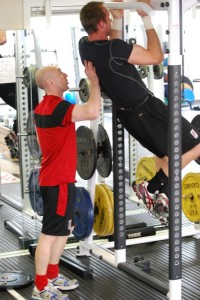
The common misconceptions are that players should not lift weights for the fear of becoming too big which makes them slow or that they should not train too close to games because the muscle soreness will impair their performance on the pitch. Neither of these are true, however after the first few sessions the initial muscle soreness decreased and Mark could see that training four times a week did not impair his performance. To improve Mark’s body composition I employed a couple of Charles Poliquin’s favourite routines, the first 3 week phase consisted of a routine called 6, 12, 25’s. This is a brutal programme that creates serious lactate build up in the working muscles and gets you shredded. The theory is that the more lactate that is produced, the more the blood pH drops causing the body to produce growth hormone. The liver then turns the growth hormone in to IGF-1, which preferentially burns stored body fat as a fuel. Here is a sample day:
Day 1 and 3
A1. Back squat heels elevated 4 x 6 4010 10 seconds rest
A2. Walking lunge 4 x 12 2010 10 seconds rest
A3. DB squats 4 x 25 1010 25 seconds rest
B1. Lying leg curl 4 x 6 4010 10 seconds rest
B2. Back extension 4 x 12 2010 10 seconds rest
B3. Supine hip extension 4 x 25 1010 25 seconds rest
The second 3-week phase utilised another of Poliquin’s concepts called German Body Comp. This routine pairs upper with lower body exercises in a superset to create whole body lactate production. Here is a sample day:
Day 1 and 3
A1. Barbell wide squats 4 x 8-10 4010 60 seconds
A2. Kneeling V pull downs 4 x 10-12 3110 60 seconds
B1. Seated leg curl feet in / down 4 x 6-8 4010 60 seconds
B2. Flat DB press 4 x 10-12 3110 60 seconds
C1. Standing EZ bar curl 4 x 8-10 3010 60 seconds
C2. Calf press 4 x 15-20 2110 60 seconds
D1. Low cable pull in 4 x 12-15 2020 60 seconds
D2. DB triceps extension 4 x 8-10 3010 60 seconds
After Mark finished the 6 weeks of body comp work he weighed 95kg with 10.9% body fat and 84.7kg lean mass – that’s almost 5kg (11lbs) of lean mass gained in 6 weeks!
The next thing to consider is the energy system requirement of a goalie differs compared to an outfield player. The energy system demand is roughly 80% from the anaerobic alactic system and 20% from the anaerobic lactic system. From this you can work out that a goalie needs to do ZERO running work as part of their fitness regimen, and training should be orientated to improve predominantly the anaerobic alactic energy system (0-20 seconds) and improve the ability to overcome inertia, i.e. strength training.
Part 3 coming soon…
Article and photos published kindly with the permission of Fulham Football Club.
